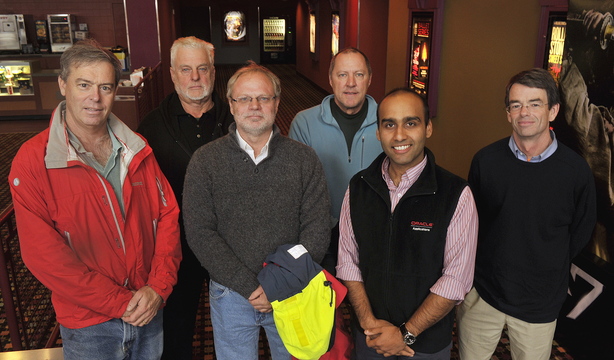Jeff Aumuller admits he was very anxious for the first 15 minutes of the new sailing movie “All is Lost,” experiencing the kind of nerves you feel in your stomach.
There was Robert Redford, at 77 just three years older than Aumuller, up on the screen, playing an unnamed man alone on a sailboat, struggling to hold it together in the Indian Ocean as water gushed through a gash – courtesy of a rogue shipping container – just above his boat’s waterline.
The engine wasn’t working, the pump handle was missing and every time Redford’s character got things under semi-control, along came another crisis. Watching the Sundance Kid flounder as he’s never floundered before, Aumuller could relate. The Portland resident has had some “death wish” moments on the Grebe, the 40-foot Colin Archer sailboat he’s owned since 1973.
Sailing movies are few and far between, and rarely do they arrive with the kind of advance acclaim that “All is Lost” has had since debuting at the Cannes film festival in May. There is Oscar talk for Redford and big praise for writer-director J.C. Chandor, who has made only one other movie, “Margin Call.”
But sailors have been tough on the movie, generating lots of online chatter about the character’s numerous mistakes, ranging from the timing of putting up the storm jib (sooner, rather than later) to the idiocy of removing the boards from the companionway hatch when the ocean is throwing itself at your vessel.
The acclaim – and the disdain – has attracted the interest of Maine’s avid sailors, six of whom accompanied a reporter Thursday to an early screening of “All is Lost.”
Among them, they had 242 years of sailing experience and had been wanting to see the film for months. How would this movie, which opens in South Portland and Waterville on Friday, rank against “Dead Calm,” “White Squall” or that New England classic, “The Perfect Storm”?
Naturally, the sailors had some issues. Just a few.
“I could nitpick 100 things he did wrong,” said Alex Agnew, publisher of Portland-based Ocean Navigator magazine. Agnew ascribed to the school of thought that the movie had to be set in the 1970s – no one would go to sea today with such a poorly equipped boat.
“That boat is not representative of what the sport is about,” he said. Among the horrors: “No handheld VHF!”
“There was one, but it got wet,” countered Peter Stoops, head of the Cruising Club of America’s Maine chapter. (Everything in the movie gets wet, including Redford. Constantly.)
Stoops has made three round trips across the Atlantic in boats similar in size to the one in “All is Lost.” He was in the more forgiving camp. So was Max Fletcher, who lives on Orr’s Island and once sailed a 32-foot boat from New Zealand to Cape Horn in 52 days, two of those days on seas so rough that the boat rolled over to a 140-degree angle, its mast submerged. Redford’s does a complete 360 in “All is Lost.”
All of the sailors were moved by the plight of Redford’s character – the existential terror of being alone at sea in a life raft with no radio, only a handful of lousy flares (the cheapest brand, Agnew said), and just a few cans of food salvaged from a sinking boat.
The film also gave them some motivation to shore up their own safety preparedness.
“I’m going to go home tonight and prepare my ditch bag,” Fletcher said.
Redford is the only person on screen in the movie, and there’s no chitter-chatter, just an SOS call and an expletive over the last, worst mistake. (“I was waiting for him to say that,” said Aumuller.)
Although he’s in crisis for most of the 1-hour, 46-minute movie, Redford’s character moves deliberately, almost slowly. Even Agnew, the most dubious of the crew at the screening, said that rang true for him. “If you are alone and in deep (expletive), you slow down,” Agnew said.
On one point, there was consensus: Redford’s character deserved credit for trying.
Ocean crossings, single-handed or otherwise, were big with sailors in the 1970s. Now, Agnew said, few people take journeys like the one depicted in “All is Lost.” Those who sail the estimated 30,000 sailboats 30-feet-or-bigger registered in the United States tend to stick closer to home.
“He made so many mistakes,” said David Dodson, a boat technician in Biddeford. “But he was there, he was doing it. He was going from point A to point B. Most of the boats that are out there, they don’t go anywhere.”
Mary Pols can be contacted at 791-6456 or at:
mpols@pressherald.com
Send questions/comments to the editors.





Success. Please wait for the page to reload. If the page does not reload within 5 seconds, please refresh the page.
Enter your email and password to access comments.
Hi, to comment on stories you must . This profile is in addition to your subscription and website login.
Already have a commenting profile? .
Invalid username/password.
Please check your email to confirm and complete your registration.
Only subscribers are eligible to post comments. Please subscribe or login first for digital access. Here’s why.
Use the form below to reset your password. When you've submitted your account email, we will send an email with a reset code.